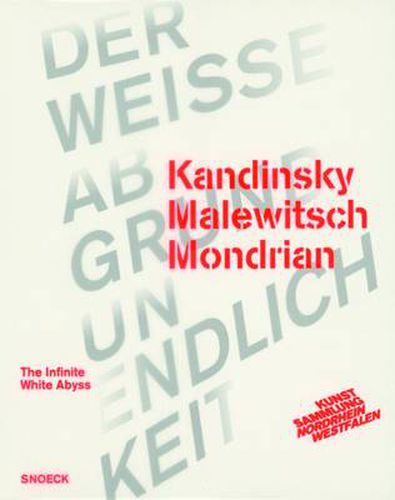Readings Newsletter
Become a Readings Member to make your shopping experience even easier.
Sign in or sign up for free!
You’re not far away from qualifying for FREE standard shipping within Australia
You’ve qualified for FREE standard shipping within Australia
The cart is loading…






The Infinite White Abyss!
KANDINSKY MALEVITCH MONDRIAN The white, free abyss–infinity lies before us , according to Kazimir Malevich in 1919 when describing his use of white as a monochrome ground in Suprematist painting and as a surface in front of which his geometric shapes seem to float weightlessly. For Wassily Kandinsky, the compositional white area in his expressive abstractions was the all-important opening of pictorial space through which the complexity of the world was to be reflected synaesthetically and thereby art simultaneously ranked alongside science. Piet Mondrian, for his part, tried to find universal harmonies through the depiction of mathematical problems behind visible phenomena. His exploration of non-colour in his grids of black lines and primary coloured surfaces forms a neoplastic system devoid of any representational function and is unique in the history of painting. On the occasion of the 2014 Quadrennial, the Kunstsammlung Nordrhein-Westfalen will premiere an attractive synopsis the work of these three great artists, considered the most prominent pioneers of the avant-garde and of abstraction in the twentieth century. The show will focus upon selected major works and the complex issue of white surfaces, all which is meticulously recreated the catalogue. The discussion of materiality and immateriality of the colour white arising here is also reflected in the latest research results from the restoration process. This leads to some surprising answers that are treated separately. If the colour white provided an umbrella for art, science and parareligions, did it necessarily have to function as a symbol of a future world?
Exhibition:
K20 Kunsthalle Nordrhein-Westfalen, Dusseldorf, 5/4-6/7/2014
$9.00 standard shipping within Australia
FREE standard shipping within Australia for orders over $100.00
Express & International shipping calculated at checkout
The Infinite White Abyss!
KANDINSKY MALEVITCH MONDRIAN The white, free abyss–infinity lies before us , according to Kazimir Malevich in 1919 when describing his use of white as a monochrome ground in Suprematist painting and as a surface in front of which his geometric shapes seem to float weightlessly. For Wassily Kandinsky, the compositional white area in his expressive abstractions was the all-important opening of pictorial space through which the complexity of the world was to be reflected synaesthetically and thereby art simultaneously ranked alongside science. Piet Mondrian, for his part, tried to find universal harmonies through the depiction of mathematical problems behind visible phenomena. His exploration of non-colour in his grids of black lines and primary coloured surfaces forms a neoplastic system devoid of any representational function and is unique in the history of painting. On the occasion of the 2014 Quadrennial, the Kunstsammlung Nordrhein-Westfalen will premiere an attractive synopsis the work of these three great artists, considered the most prominent pioneers of the avant-garde and of abstraction in the twentieth century. The show will focus upon selected major works and the complex issue of white surfaces, all which is meticulously recreated the catalogue. The discussion of materiality and immateriality of the colour white arising here is also reflected in the latest research results from the restoration process. This leads to some surprising answers that are treated separately. If the colour white provided an umbrella for art, science and parareligions, did it necessarily have to function as a symbol of a future world?
Exhibition:
K20 Kunsthalle Nordrhein-Westfalen, Dusseldorf, 5/4-6/7/2014